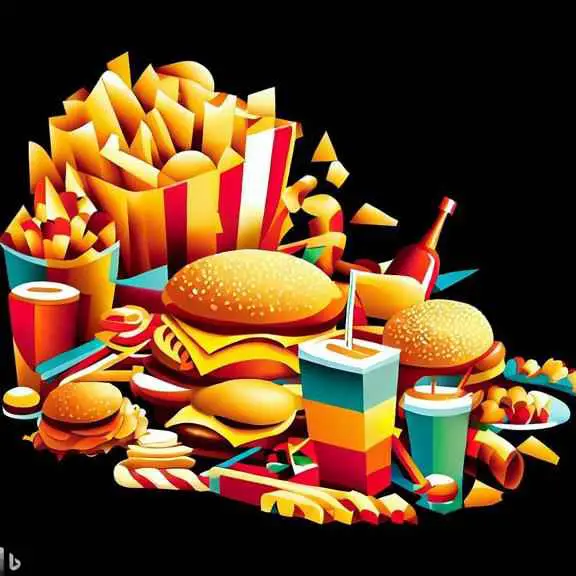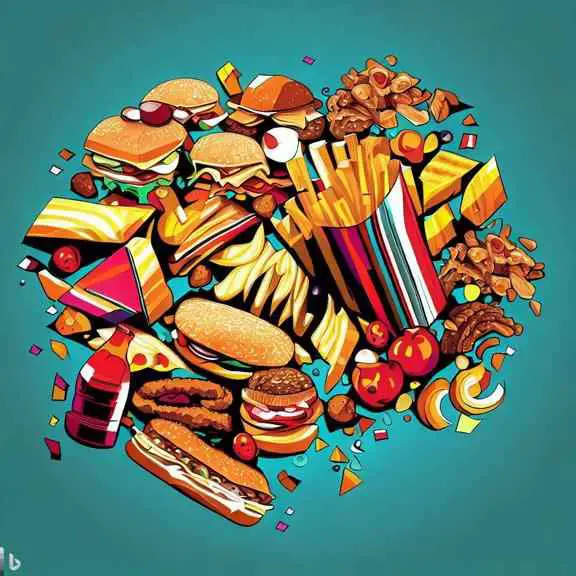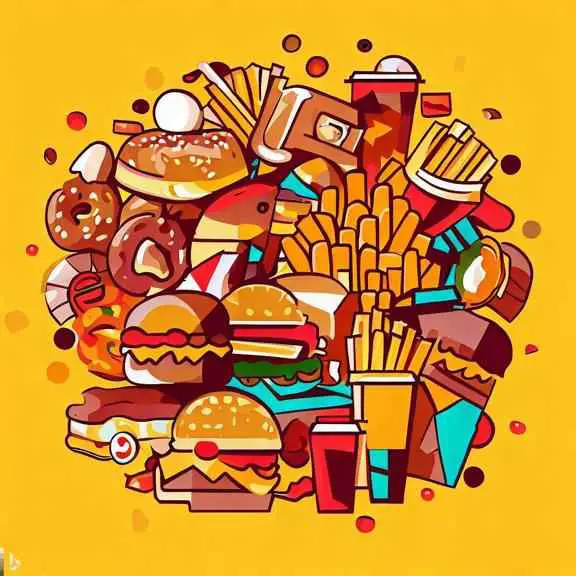Paragraph on
Junk Food
for all Class, Words
by Food on
Junk food is often referred to as a type of food that is high in calories, unsaturated fats, sugars, and salt but low in essential nutrients…, please continue reading.

Table of Content
Ad
The Paragraph on Junk Food
Ad
Junk food is often referred to as a type of food that is high in calories, unsaturated fats, sugars, and salt but low in essential nutrients. This type of food is typically processed and marketed for convenience, making it easier for people to grab a quick meal on the go. While it may seem like a convenient option, there are many health risks associated with consuming too much junk food.
One of the biggest concerns with junk food is its impact on weight and obesity. Junk food is often high in calories, which can quickly add up if eaten on a regular basis. This can lead to weight gain, which in turn can lead to obesity. Obesity is associated with a host of health problems, including diabetes, heart disease, and certain types of cancer.
Another concern with junk food is its impact on mental health. Studies have shown that a diet high in junk food can lead to depression and anxiety. This may be due in part to the fact that junk food tends to be low in essential nutrients like vitamins and minerals, which can affect brain function.
Despite the health risks, junk food remains incredibly popular around the world. This may be due in part to the fact that it is often more affordable and readily available than healthier food options. However, with more and more people becoming aware of the dangers of junk food, there is a growing movement towards healthier eating habits.

Questions about Junk Food
Ad
Questions and Answers:
- What is junk food?
- Junk food is a type of food that is high in calories, unsaturated fats, sugars, and salt but low in essential nutrients.
- What are the health risks associated with consuming too much junk food?
- The health risks associated with consuming too much junk food include weight gain, obesity, diabetes, heart disease, and certain types of cancer.
- Why is junk food often marketed for convenience?
- Junk food is often marketed for convenience because it can be easily grabbed and eaten on the go.
- What is the impact of junk food on mental health?
- Studies have shown that a diet high in junk food can lead to depression and anxiety, possibly due to the lack of essential nutrients.
- Why is junk food so popular despite its health risks?
- Junk food is often more affordable and readily available than healthier food options.
- What is the growing movement towards healthier eating habits?
- The growing movement towards healthier eating habits involves people becoming more aware of the dangers of junk food and choosing to eat healthier options.
- What health concerns are associated with obesity?
- Obesity is associated with diabetes, heart disease, and certain types of cancer.
- What can be a reason for the lack of essential nutrients in junk food?
- Junk food tends to be low in essential nutrients like vitamins and minerals due to the processing involved in making it.
- Why is it important to be aware of the dangers of junk food?
- It is important to be aware of the dangers of junk food in order to make informed decisions about one’s diet and overall health.
- What are some healthier options to choose over junk food?
- Some healthier options to choose over junk food include fruits and vegetables, lean proteins, and whole grains.

Vocabulary related to Junk Food
Ad
Vocabulary Words:
- Calories: Units of energy in food.
- Usage: The nutrition label on the back of food packages lists the number of calories per serving.
- Synonyms: Energy, kilocalories
- Antonyms: None
- Unsaturated fats: Fats that are liquid at room temperature and tend to be healthier than saturated fats.
- Usage: Avocado, olive oil, and nuts are all sources of unsaturated fats.
- Synonyms: Monounsaturated fats, polyunsaturated fats
- Antonyms: Saturated fats
- Sugars: Simple carbohydrates that provide energy.
- Usage: Added sugars can be found in foods like candy, soda, and baked goods.
- Synonyms: Fructose, glucose
- Antonyms: None
- Convenience: The state of being easy or quick to do.
- Usage: Junk food is often marketed for convenience because it can be easily grabbed and eaten on the go.
- Synonyms: Ease, accessibility
- Antonyms: Inconvenience
- Obesity: The state of being extremely overweight.
- Usage: Obesity is associated with a host of health problems, including diabetes and heart disease.
- Synonyms: Overweight, adiposity
- Antonyms: Thinness
- Depression: A mental health disorder characterized by persistent feelings of sadness and hopelessness.
- Usage: Junk food has been linked to depression and anxiety.
- Synonyms: Melancholy, despondency
- Antonyms: Happiness
- Anxiety: A mental health disorder characterized by excessive worry and fear.
- Usage: Junk food has been linked to depression and anxiety.
- Synonyms: Tension, nervousness
- Antonyms: Calmness
- Essential nutrients: Nutrients that the body needs but cannot produce on its own, so they need to be obtained through food.
- Usage: Junk food tends to be low in essential nutrients like vitamins and minerals.
- Synonyms: Vital nutrients, necessary nutrients
- Antonyms: Nonessential nutrients
- Affordability: The state of being able to be afforded.
- Usage: Junk food is often more affordable than healthier food options.
- Synonyms: Accessibility, attainability
- Antonyms: Unaffordability
- Readily available: Easily and quickly accessible.
- Usage: Junk food is often more readily available than healthier food options.
- Synonyms: Accessible, on-hand
- Antonyms: Inaccessible

Structure of the sample "Junk Food" paragraph
Ad
Cohesion and coherence: In writing the above paragraph, cohesion and coherence were maintained through the use of language and structure. Transition words like “however” and “despite” were used to link ideas and indicate contrast or continuation. Parallel structure was also employed in the last sentence of each paragraph, where short, declarative statements summarizing the main point were used. The paragraph began with a clear topic sentence defining junk food and was followed by supporting sentences explaining the health risks of consuming too much of it, and finally, a sentence summarizing the growing movement towards healthier eating habits.
